
Insects in the family Tettigoniidae are commonly called katydids, or bush crickets. They have previously been known as "long-horned grasshoppers". More than 6,400 species are known. Part of the suborder Ensifera, the Tettigoniidae are the only extant (living) family in the superfamily Tettigonioidea.

Horace Bénédict de Saussure was a Genevan geologist, meteorologist, physicist, mountaineer and Alpine explorer, often called the founder of alpinism and modern meteorology, and considered to be the first person to build a successful solar oven.

Amos Emerson Dolbear was an American physicist and inventor. Dolbear researched electrical spark conversion into sound waves and electrical impulses. He was a professor at University of Kentucky in Lexington from 1868 until 1874. In 1874 he became the chair of the physics department at Tufts University in Medford, Massachusetts. He is known for his 1882 invention of a system for transmitting telegraph signals without wires. In 1899 his patent for it was purchased in an unsuccessful attempt to interfere with Guglielmo Marconi's wireless telegraphy patents in the United States.

Gryllinae, or field crickets, are a subfamily of insects in the order Orthoptera and the family Gryllidae.

The Cape honey bee or Cape bee is a southern South African subspecies of the western honey bee. They play a major role in South African agriculture and the economy of the Western Cape by pollinating crops and producing honey in the Western Cape region of South Africa.

Dolbear's law states the relationship between the air temperature and the rate at which crickets chirp. It was formulated by Amos Dolbear and published in 1897 in an article called "The Cricket as a Thermometer". Dolbear's observations on the relation between chirp rate and temperature were preceded by an 1881 report by Margarette W. Brooks, although this paper went unnoticed until after Dolbear's publication.

The Cape weaver is a species of bird in the weaver family, Ploceidae, found in southern Africa.

The African clawless otter, also known as the Cape clawless otter or groot otter, is the second-largest freshwater otter species. It inhabits permanent water bodies in savannah and lowland forest areas through most of sub-Saharan Africa. It is characterized by partly webbed and clawless feet, from which their name is derived. The word 'aonyx' means clawless, derived from the prefix a- ("without") and onyx ("claw/hoof").

Tree crickets are insects of the order Orthoptera. These crickets are in the subfamily Oecanthinae of the family Gryllidae.
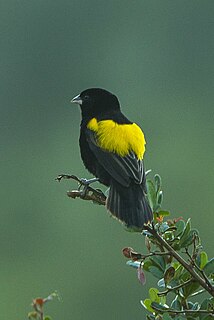
The yellow bishop, Cape bishop, Cape widow or yellow-rumped widow is a resident breeding bird species in Angola, Botswana, Burundi, Cameroon, Congo, Equatorial Guinea, Eswatini, Ethiopia, Kenya, Lesotho, Malawi, Mozambique, Nigeria, Rwanda, South Africa, South Sudan, Tanzania, Uganda, Zambia and Zimbabwe.

The Cape bunting is a passerine bird in the bunting family Emberizidae.
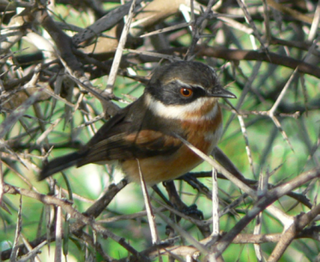
The Cape batis is a small, stout insect-eating passerine bird in the wattle-eye family. It is endemic to the Afromontane forests of southern Africa.

The East African lowland honey bee is a subspecies of the western honey bee. It is native to central, southern and eastern Africa, though at the southern extreme it is replaced by the Cape honey bee. This subspecies has been determined to constitute one part of the ancestry of the Africanized bees spreading through North and South America.
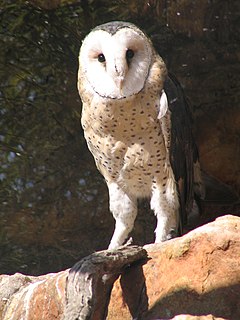
The African grass owl is a species of owl in the barn owl family, Tytonidae.
Gryllotalpa major,also known as the Prairie Mole Cricket, is endemic to the United States and is the largest cricket in North America. Its natural habitat is temperate grassland and it belongs to the family Gryllotalpidae. It is threatened by habitat loss, and is currently only found in Oklahoma, Kansas, Missouri, Nebraska and Arkansas. Males of this species produce sounds by rubbing their fore wings together. They sing from special burrows they construct in the prairie soil to attract females for mating, and they can be heard at distances up to 400 m from the burrow. Males aggregate their acoustic burrows in a lek arena and are very sensitive to vibrations carried through the ground. Males communicate with neighboring males through vibrational signals, and the songs they project to flying females are harmonic chirps, rather than the trills produced by most mole crickets.
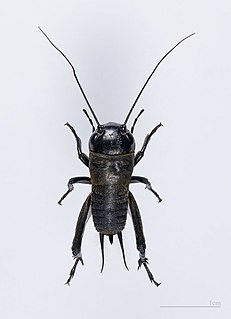
Crickets are orthopteran insects which are related to bush crickets, and, more distantly, to grasshoppers. In older literature, such as Imms, "crickets" were placed at the family level, but contemporary authorities including Otte now place them in the superfamily Grylloidea. The word has been used in combination to describe more distantly related taxa in the suborder Ensifera, such as king crickets and mole crickets.

Oecanthus fultoni, also known as the snowy tree cricket, or thermometer cricket, is a species of tree cricket from North America. It feeds on leaves but also damages fruit. The chirp of this species is often dubbed onto sound tracks of films and television shows to depict a quiet summer's night. The rate of chirp varies depending on the heat of the environment, allowing a listener to estimate the temperature.

Gryllus assimilis, commonly known as the Jamaican field cricket and sometimes referred to as the silent cricket among other names, is one of many cricket species known as a field cricket. Its natural habitats are the West Indies and parts of the southern United States, Mexico, and South America, though as a result of widespread breeding programs to supply feeder insects to the pet industry since 2010, it has become available commercially throughout North America and Europe.
Oecanthus argentinus, the prairie tree cricket, is a species of tree cricket in the family Gryllidae. It is found in North America and South America.
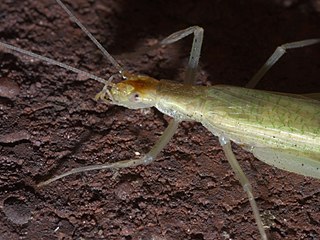
Oecanthus niveus, known generally as the narrow-winged tree cricket or snowy tree cricket, is a species of tree cricket in the family Gryllidae, which includes all crickets. First noted by Swedish Entomologist Charles de Geer in 1773 by a Pennsylvanian Specimen, it is found primarily in Eastern North America south of Canada, and also in the Caribbean.
















